If you suffer from persistent headaches, neck aches, you could be at risk for TMJ Syndrome. Symptoms of people who suffer from TMJ syndrome can often present with the following symptoms:
1. Persistent headaches, often in temporal areas, but also commonly at the base of the skull. Sufferers of TMJ often wake up with the headaches, and these can often be worse on one side.
2. Persistent neck pain or stiffness, unable to turn head freely. These symptoms can range from mild to severe and often are constant to a daily occurrence.
3. Grinding or clenching or Bruxism. There are often signs of wear on teeth indicating bruxism or clenching. The patient may or may not be aware of this as it often happens in the sleep. We can assess the degree of wear and that will usually be an indication of this occurrence.
4. Abfractions or notching at the necks of some teeth. The scientific term is Abfractions. These are caused by flexion of the teeth from grinding or clenching and it causes the tooth to flex and the enamel to chip off the side necks of teeth leaving notches in the tooth structure at the gum level.
5. Jaw or facial muscular pain. The facial muscles can be tense or sore, like a constant ache. It can sometimes feel like pain behind the eyes.
6. Ear congestion. This is common and can be on one side or both. The sensation of blocked ears, or difficulty in equalising pressure or constant pressure in the ears.
7. Ear Ringing or Tinnitus.
8. Head tilts, in every direction except upright.
9. Tingling finger tips
10. Vertigo or dizziness and lack of balance
11. Lack of muscle strength
What is TMD or TMJ Syndrome?
Temporomandibular Joint Dysfunction or Temporomandibular Joint Syndrome essentially is a series of symptoms or disorders that stem from an unbalanced jaw joint caused from a bite that is not in harmony with the joints, muscles and nerves.
Basically, the bite, occlusion , or the way our teeth fit together is where we have to function. Where the teeth fit is where we have to hold our jaw, and chew, and talk and where the teeth fit, determines where the jaw has to sit, and that determines where the muscles and jaw joint then has to sit, as a result of the where the bite lines up. Sometimes, where this position is, not in the ideal position for the joints themselves, or the muscles to be in relaxed position. For all to work in harmony, the Joints, the Muscles, and the teeth are an intricate balance.
In patients who have TMJ syndrome, these 3 elements are often not in harmony with each other. Thus there is a Muscle /Joint vs Tooth war going on. Whilst the teeth make the muscles and joints sit in a nonrelaxed state, the muscles and joints fight back (usually at night ) by causing teeth grinding. In the end, no one wins. The muscles and joints hurt (or click) and the teeth all wear away. This is usually the fate of the TMJ patient.
What Can Be Done to Treat TMJ Syndrome?
There are a few alternatives to treatment, depending on the severity of the symptoms and whether you are merely treating the symptoms are whether you want to get down to treat the cause.
1. Botox or botulinum toxin injections in to the muscles involved. Botox can be injected into the jaw muscles to reduce muscle activity by temporarily paralysing the jaw and clenching muscles. You can also inject them into the muscles of the temples to reduce tension headaches. Keep in mind this is just treating the symptoms and not the cause.
2. Splint therapy to protect the teeth from further wear. There are splints that can be made to sit on the teeth at night to prevent them from clenching and wearing each other. They act as a physical barrier to protect the teeth. With this splint it will not change the bite and teeth will still continue to grind and clench, however, the teeth will be protected. This may be enough for people who experience no muscle pain and just want to protect from grinding away teeth. This should be worn to bed at night.
3. Gneuromuscular or Neuromuscular Treatment. Is basically treatment that focuses on masticatory and body alignment. When the alignment and harmony of the TMJ, muscles and teeth are created by the Gneuromuscular orthotic, many of the symptoms caused by muscle pain and tension like headaches, neck pain, jaw or face pain will be eliminated. Also muscles and joints in harmony with teeth will not grind or clench the teeth anymore. The Gneuromuscular orthotic is customed designed to the exact jaw recordings specifications that were measured and recorded during treatment. The Computer diagnostics and use of a TENS neurotransmitter are used in recording and refining the patient’s physiologic resting and functioning muscles. This is the treatment treats the problem from the source (lack of alignment) and fixes the problems from the cause, and not just the symptoms.
What Is Involved In The Gneuromuscular Treatment?
This is the sequence of treatment done in our practice.
TMJ consult 1. (80 mins)
Thorough examination of oral health, posture.
Medical and dental history
Thorough review of all previous treatments and outcomes.
Head and neck evaluation
Occlusal evaluation
Diagnosis
signs and symptoms
radiographs taking and review
Discussion of diagnosis and options
TMJ consult 2. ( 3 hours)
Sonography
Electromyographic (EMG )recordings of the muscle activities at rest and in function
Computerised mandibular scanning and jaw tracking recordings and documentation.
Low-Frequency TENS
Muscle relaxation therapy
Jaw exercises to recapture the TMJ disc
Capturing of the Gneuromuscular bite using the low-density TENS and verified with the EMGS.
TMJ Consult 3 (10 mins)
Delivery of gneuromuscular orthotic that is custom built to the physiologic resting position of the jaw and muscles.
The patient will wear this orthotic for a week before the next visit to allow some time to get used to it.
Gneuromuscular orthotic fine tuning appointment (2 hours)
TENS is used to relax the muscles to physiologic rest
Computer tracking and Electromyographic tracing is used to refine and adjust the custom made Gneuromuscular orthotic to the physiologic rest position for the muscles.
This is tested with EMG tracings as well as Muscle testing with strength tests.
Follow-up appointments
These may be needed depending on the healing and progress will be assessed in each case.
If you want to find out how we can help your persistent head, neck or jaw pains, pvisit our website at www.smiledesignstudio.com.au or call us for a free consult at 93852000 and see if Gneuromuscular Dentistry can help you.
Dr Vicky Ho is among the leading dentists in the world in Cosmetic, implant and TMJ dentistry. She has received qualifications from around the world’s top institutions, including the Las Vegas Institute of Advanced Dentistry, Occlusion connections with Dr. Clayton Chan, the world’s authority in TMJ dysfunction and Gneuromuscular dentistry, as well as finishing her Masters clinician course with gIDE Implant Dentistry in Loma Linda University and UCLA in California. She strives to continually better herself every day in her skills and knowledge in a quest for constant and never ending improvement to be able to provide her patients with the best care possible with latest techniques, materials and technology.
For more information about our Cosmetic Dentistry in Mosman Park, Perth, call (08) 9468 3322 for a Free Smile Assessment.
LET’S CONNECT!
Facebook
Twitter
Pinterest
Check out our Reviews today!









